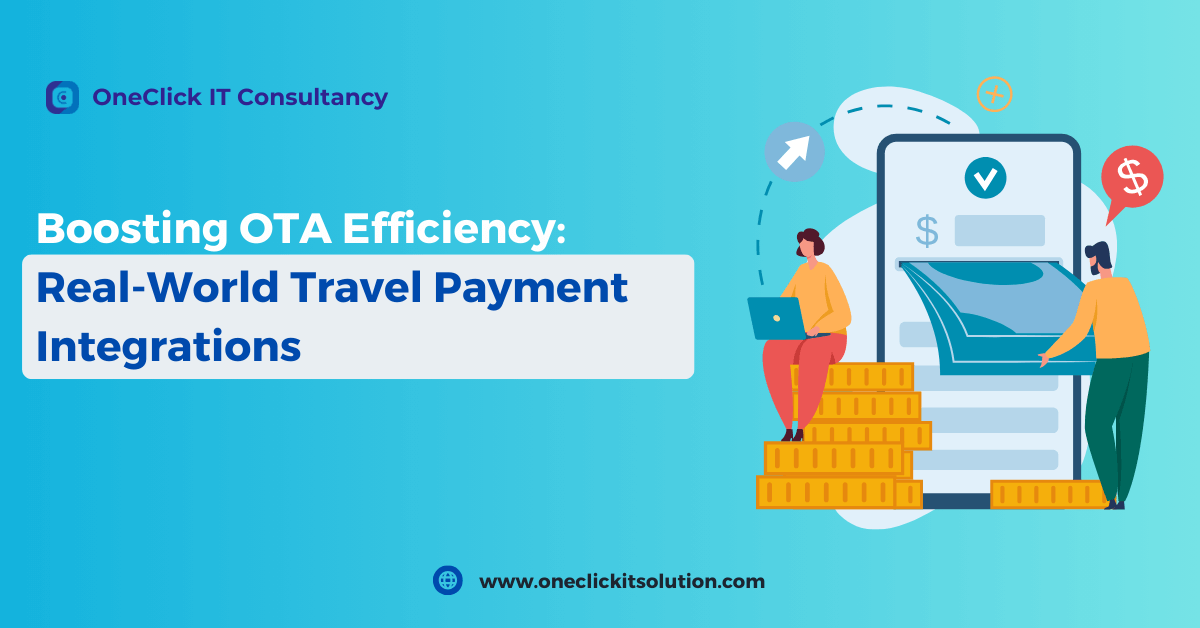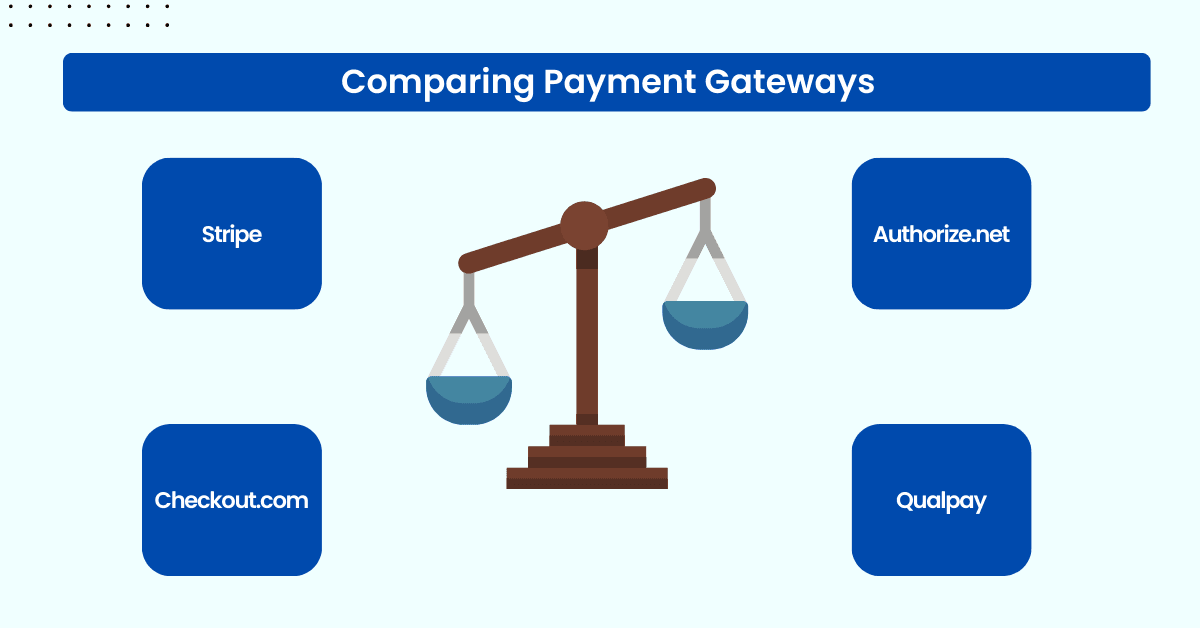Boosting OTA Efficiency: Real-World Travel Payment Integrations

Are you struggling with slow OTA payment processing? Learn how real-world travel payment integration can improve your business’s flow.
With the travel and tourism industry increasingly moving towards online sales, the ability to accept payments electronically is instrumental for any travel business. Both the travel and hospitality sectors are recovering worldwide, benefiting from the growth of online travel agencies.
OTAs are critical contributors to the recovery of this vital worldwide industry, directly assisting millions of small- and medium-sized firms. According to data from the Pacific Asia Travel Association, OTAs achieved almost 40% penetration of the worldwide market share of hotels, packaged tours, airlines, railways, and cruises. They are predicted to become even more significant, with OTAs set to generate over $1,500 billion globally by 2027, based on estimations between 2021 and 2027.
OTAs operate on low-profit margins, so they must optimize their operations to maintain and expand their businesses. One critical optimization aspect is establishing a seamless yet cost-effective payment process that reduces the risk of end-user checks while safeguarding the operator’s profitability. Integrating this payment solution can help boost online payment processing and streamline operations.
Payment Essentials: Key Considerations for Accepting Credit Cards
Before going into the intricacies, discussing the critical questions that arise during the integration process is important.
1. How to complain to PCI DSS:
Maintaining the stringent criteria under the Payment Card Industry Data Security Standard is imperative for those entering the commerce arena. This comprehensive standard established by the leading credit organizations aims to protect confidential consumer data. While the technical and operational management may appear daunting at first glance, a thorough understanding of what PCI DSS compliance entails and a diligent implementation strategy will help chart a smooth path forward into this innovative digital phase of business.
Travel companies often reduce PCI DSS scope by leveraging third-party services, minimizing their interactions with sensitive data.
2. To decide whether to be a Merchant of Record (MoR) or not:
Your role as a MoR significantly influences your payment and data security stack. An MoR is a business entity responsible for selling products to end customers, managing financial transactions, maintaining merchant accounts, handling taxes, processing refunds and chargebacks, and ensuring fraud protection.
While some businesses manage payments independently, many travel resellers prefer entrusting these responsibilities to other entities. This is particularly common in the travel industry, where OTAs often delegate payment processing to airlines or hotels, acting as MoRs.
3. What is the Right Payment Gateway?:
Integrating with a payment gateway for a travel agency becomes imperative if you opt to be an MoR. These services provide a secure infrastructure for processing online transactions.
4. How many payment flows do you need to Implement?:
The number of travel payment scenarios you need to develop around the gateway integration depends on the breadth of travel suppliers you aim to collaborate with as an MoR.
Addressing these issues meticulously can ensure a robust and seamless travel payment integration tailored to your travel business needs.

Exploring Payment Gateways in Travel: Selection Criteria and Popular Options
Selecting the right payment gateway for travel agency entails carefully considering various factors pertinent to any eCommerce business, not just travel-specific ones. Here are key questions to address:
1. What is the Cost Structure?
Understand the fee structure associated with processing travel payment through the gateway. Providers may charge fixed fees per transaction, a percentage of the product price, a combination of percentage and fixed fee, or a minimum transaction value. Additionally, inquire about setup and monthly fees that impact your overall costs.
2. What is the supported Currency and Payment Method Support?
Ensure the payment gateway for travel agency supports the currencies and payment methods relevant to your business and target audience. For instance, if your merchant account operates in Saudi Arabia, the gateway should handle Saudi riyals (SAR) and facilitate currency conversions. Verify if the provider accepts preferred payment methods in your clients’ regions, such as local e-wallets, national credit cards, and bank transfers. Given the rise of short-term credits like “buy now, pay later” in travel, consider if the gateway supports such payment options to enhance customer convenience.
3. What fraud prevention measures are being leveraged?
Evaluate the travel payment gateway’s fraud prevention capabilities. Determine how it identifies and mitigates suspicious activities and fraudulent transactions. Check for features for fraud detection. Businesses need to be safeguarded from scams and fraudulent activities. These requirements safeguard businesses against scams and fraudulent activities, and the processing of transactions becomes safe and easy in this marketing industry.
4. What is the Quality of Technical Documentation?
When payment gateways are being evaluated, the quality of technical documentation is crucial in determining their suitability for integration. The public availability of technical documentation, without the need to sign contracts, indicates a stable and developer-friendly travel agent payment system. Ivan Mosiev emphasizes, “Public availability typically means the travel agent payment system is stable and easy to integrate with.” Conversely, private access to documentation may signal poor API quality, leading to a challenging implementation process.
Considering these factors, let’s review different payment gateway for travel agency. While these gateways may not be the perfect fit for everyone, they have demonstrated reliability and ease of integration. They offer modern REST APIs, SDKs for various programming languages, and comprehensive, publicly accessible documentation, ensuring a smooth travel payment integration experience.
The payment gateway for travel agency mentioned above are certified as Level 1 PCI DSS service providers, ensuring robust security standards. Therefore, our focus will shift to other critical parameters, including pricing structures, supported currencies and payment methods, target markets, fraud detection capabilities, and partnerships within the travel industry.
Comparing Payment Gateways

Stripe
Stripe began operations in 2010 and was founded in San Francisco to make payments online simple and accessible worldwide. Today, it serves businesses across 46 nations, supporting over 135 currencies. While centering efforts in North America and Europe, Stripe also caters to Asia by integrating popular payment tools like China UnionPay, Alipay, and WeChat Pay for streamlined cross-border transactions.
Stripe employs sophisticated fraud detection powered by machine learning algorithms to shield clients from losses. Trained on a vast volume of travel payment records, the system called Radar identifies suspect activity in real-time at a cost of a few cents more per screened transaction versus the baseline fee of 2.9% plus 30 cents. Setup and monthly subscription expenses are forgone.
Stripe has since then been used for travel payment solutions as numerous travel companies leverage Stripe’s full-service payment processing, such as TripAction, to simplify reservations and WeTravel to handle international bookings frictionlessly.
Checkout.com
Checkout.com was established in 2009 in Singapore before it was moved to London. It has become Europe’s most valuable fintech startup, operating in nearly 50 countries worldwide. Despite its European base, the company maintains a strong foothold in Asian and Middle Eastern markets, where its journey to success began by processing travel payment solutions for Hong Kong businessmen.
With partnerships with Alipay and six other Asian digital wallets, three Middle Eastern card networks, and Egyptian e-payment solution Fawry, Checkout.com is deeply entrenched in these regions. OneClick’s firsthand experience with Checkout.com during the modernization of an OTA from Saudi Arabia underscores its popularity in the Middle East. Another Saudi client, Seera Group, benefits from Checkout.com’s seamless travel payment integration with regional travel payment methods like Saudi Arabia’s Mada debit cards and Kuwait’s KNET.
Checkout.com is a preferred European choice for travel businesses, including Etraveli Group in Sweden, Dott in the Netherlands and France, and Mirai in Spain.
Checkout.com comes equipped with Fraud Detection Pro, which utilizes machine learning algorithms to detect suspicious activities. Moreover, users can customize fraud prevention rules to combat scams effectively. All of the above features make Checkout.com one of the leading and well-tailored providers for oral business owners. In terms of pricing, they are available upon request.
Authorize.net
Since 1996, Authorize.net has provided wonderful opportunities to help small and medium-sized businesses with credit card processing facilities across the United States. Now, Authorize. Net is owned by Visa, the world’s second-largest card network. Authorize.net is one of the most frequently used payment gateways in the United States.
While its currency portfolio is more modest than competitors like Stripe and Checkout.com, which support 12 currencies and major card networks, Authorize.net also facilitates eChecks and two global digital wallets—PayPal and Apple Pay. Its services extend to businesses in the USA, Canada, and Australia, enabling them to accept payments globally. Notable clients in the travel industry include Rezdy, Rezgo, Xola, and Softrip, among others.
Offering two pricing plans — with or without a merchant account — Authorize.net equips businesses with an Advanced Fraud Detection Suite comprising 13 filters to safeguard against fraudulent transactions.
Qualpay
Established in 2014 in California, Qualpay is another single payment processing platform suitable specifically for small US-based e-commerce businesses. Unlike Authorize.net, Qualpay is a payment gateway and merchant account in one, shortening the payment order.
Qualpay Qualpay, like many payment gateway for travel agency, supports major global cards, Google Pay, and ACH bank transfers, with Visa and Mastercard currencies totaling over 150. While lacking a separate fraud detection tool, Qualpay provides essential settings to prevent fraudulent activities, such as blocking duplicate transactions, specific IP addresses, and transaction monitoring capabilities.
With its straightforward approach and comprehensive payment solutions, Qualpay is a reliable ally for small US enterprises seeking efficient payment processing.
Integrating payment gateways may seem straightforward with modern APIs and detailed documentation. However, the real challenge lies in understanding and implementing various payment scenarios tailored to the travel industry’s unique demands.
1. Travel Payments with Debit and Credit Cards:
Accepting credit and debit cards often entails distinct payment flows, even within a single platform. With credit card payments, funds are initially placed on hold upon booking, pending confirmation from the airline or hotel. Upon confirmation, the payment is processed; otherwise, the hold is released.
Conversely, debit card transactions are immediate, resulting in instant payment upon reservation. However, this instant transaction poses risks, particularly if the booking is denied. Refunds become complex, entailing fees, commissions, and currency exchange rates, with customers awaiting reimbursement.
Debit card dominance in markets like the Middle East amplifies these risks, given cultural preferences favoring debit over credit cards. To mitigate such challenges, tailored payment flows, such as tokenization and internal digital wallets, may be necessary, as exemplified in our partnership with a Saudi Arabian client.
2. Flight Payment Flows: Understanding Complexities in Airline Transactions
The payment processes associated with flights introduce unique challenges, particularly concerning full-service carriers and low-cost airlines.
- 1. Full-Service Carriers: Booking and ticketing operations are distinct, with a time gap between a seat reservation and payment. Transactions are processed through IATA’s BSP or its US counterpart, the Airline Reporting Corporation (ARC).
- 2. Low-Cost Airlines (LCCs): LCCs follow an immediate ticketing model, almost instantly confirming bookings and charging customers’ cards, bypassing BSP or ARC procedures. Selling LCC flights through an OTA requires additional payment flows.
Amadeus, for instance, manages separate sources of GDS and LCC content. Since LCCs practice instant confirmation, payment is made before booking, posing challenges if reservations are not confirmed. In such cases, an internal OTA payment system proves beneficial, allowing funds to remain accessible for rebooking rather than initiating a lengthy refund process.
3. NDC Payments and Ancillaries: Adapting to New Distribution Capability Challenges
Implementing New Distribution Capability (NDC) in the airline industry presents fresh hurdles in payment processing, particularly concerning ancillary services sold through third-party platforms.
Despite the promise of NDC for airlines to offer ancillaries via third-party channels, integrating these services into a single receipt remains elusive. Instead of a consolidated transaction, multiple smaller transactions occur, resulting in separate proofs of payment—a traditional airline ticket and an Electronic Miscellaneous Document (EMD) for ancillaries.
The industry anticipates the One Order initiative to resolve this issue by consolidating all flight components into a single document per passenger. Until then, OTAs and their technology partners must navigate the complexities arising from multiple transactions and varied methods of ancillary charges by airlines.
4. Hotel Payment Flows: Navigating Diverse Booking Policies
Hotel transactions present even more intricacies than flights, as each property and bed bank may enforce distinct rules and cancellation policies.
Bookings range from non-refundable, with instant charges, to partially refundable, where the property retains payment but refunds a portion upon cancellation based on the remaining days before arrival.
Hotels often require access to guests’ credit card details as a precaution against loss. In such cases, the OTA acts as a guarantor, and accommodations may charge cancellation fees or full room prices for no-shows, settling payment upon arrival.
OTAs may remit funds to hotels immediately or tokenize payment details for later charges. This variability necessitates meticulous programming on the OTA’s side to accommodate diverse payment scenarios.

Overcoming Payment Challenges: A Guide for OTAs
1. Addressing Expensive Cross-Border Payments
As the global marketplace expands, OTAs face the challenge of expensive cross-border payments. To mitigate these costs and risks, OTAs must prioritize reliable and cost-effective travel payment solutions that cater to global trade requirements. Embracing virtual cards and mobile payments, which promise low risk and easy integration, can significantly reduce charges and streamline cross-border transactions. Additionally, staying informed about emerging trends like virtual cards’ projected growth can inform strategic decision-making for cost-effective payment modes.
2. Managing Payment Fraud Risks
Effective payment mechanisms protect firms from the associated investment fraud risks. This is due to the high losses to the company’s possible profit margins and reputation. Therefore, OTAs must invest in partnerships with payment providers with secure platforms and acceptable payment methods. Although the use of virtual cards is more secure, payment through card-not-present requires vigilant opposition to possible fraud risks.
3. Simplifying Complicated Reconciliation
Complex cross-border payments, chargebacks, and other issues lead to cumbersome transaction reconciliations that are costly and time-consuming for OTAs. Virtual cards provide a solution that simplifies the reconciliation process through reduced manual work and improved fraud detection, resulting in better operational outcomes and enhanced efficiency.
4. Ease Dispute and Reimbursement Processes
Payment disputes, chargebacks, and reimbursements are another frequent problem for OTAs. Therefore, it is advisable to collaborate with travel payment providers that ensure dispute resolution, whether for chargebacks on card payments or virtual cards that guarantee better protection from fraud.
5. Enhancing Liquidity Management
Maintaining stable cash flows is essential for OTAs, particularly in the travel industry with slim profit margins. To improve liquidity, OTAs should adopt strategic payment strategies, such as leveraging virtual cards to extend the duration of funds held in accounts. By customizing transaction dates, OTAs can effectively optimize cash flow management and sustain liquidity levels.
OneClick IT Consultancy: Transforming Payment Efficiency for OTAs
As a global platform specialising in cross-border and multichannel payments, OneClick offers travel payment solutions to enhance OTAs’ payment efficiency. By reducing foreign exchange and transaction fees, speeding up money collection and bank transfers, and enabling real-time payments worldwide, OneClick empowers OTAs to navigate travel payment challenges seamlessly. With OneClick, OTAs can expand globally, manage payment needs in new geographies, and enhance the convenience, transparency, and boost online payment, ultimately driving business growth and success.
Conclusion
Real-world travel payment integration is crucial for enhancing OTA efficiency and driving success in the rapidly expanding travel industry. When equipped to address key pain points like costly cross-border payments, susceptibility to fraud, complex reconciliations, disputes, and limited liquidity access, OTAs can streamline operations, nurture lasting customer relationships, and ensure profitability.





